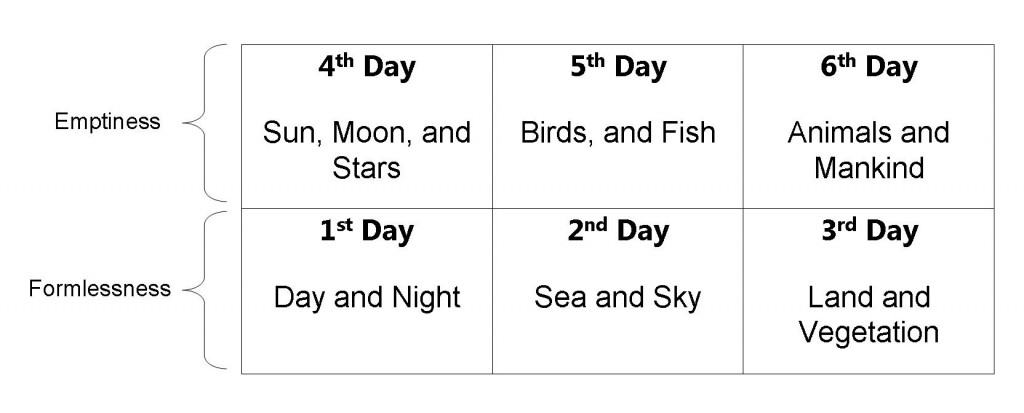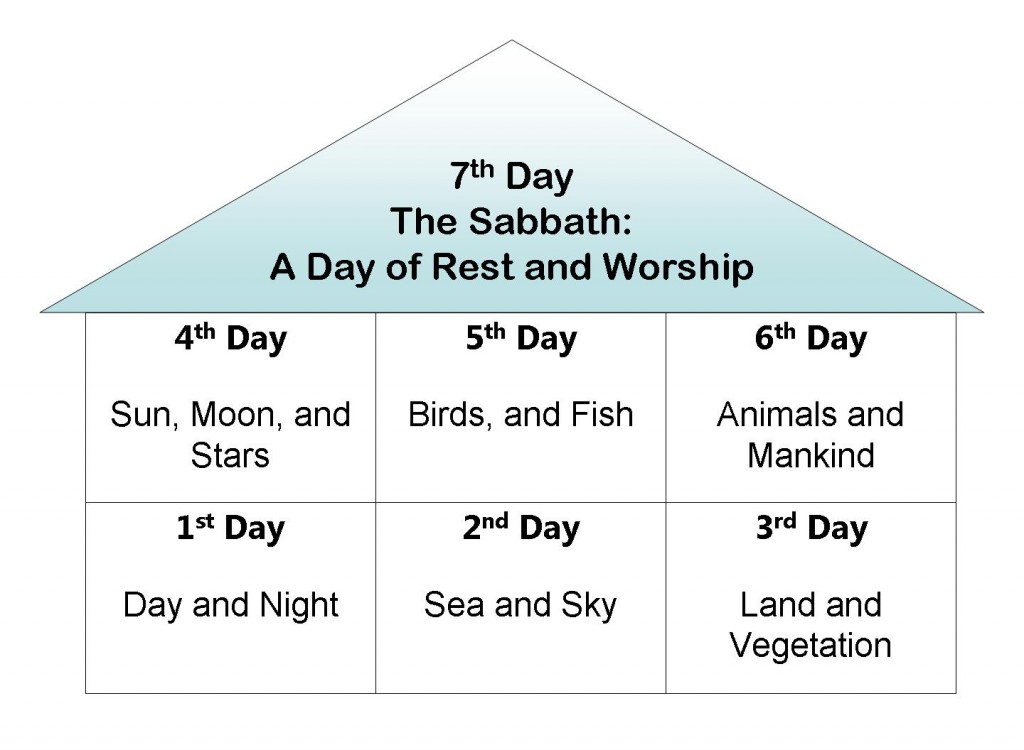 The eternal love story told to us in Scripture begins in a simple way: “In the beginning God created the heavens and the earth.” Without toil or a “big bang,” God simply speaks creation into existence.
The eternal love story told to us in Scripture begins in a simple way: “In the beginning God created the heavens and the earth.” Without toil or a “big bang,” God simply speaks creation into existence.
- 2 Maccabees 7:28: Look at the heavens and the earth and see everything in them, and recognize that God made them out of nothing.
Too often, we read the story of creation in a way that pits religion against science. That is not the purpose of this lesson. Yes, we affirm the account of Genesis as God’s inerrant Word. Yet, if our focus of creation is whether the account is true instead of the account itself, then we miss what the text is telling us.
The Holy Spirit through Moses wants to teach us something about the purpose for which God first made the world. The Bible begins with an elegant, simple statement: “In the beginning God created the heavens and the earth” (Genesis 1:1). Then it gets into the specifics!
The next verse says, “And the earth was without form and void, and darkness was over the face of the deep” (Genesis 1:2). The picture here is of a world–or universe–that exists, but is still not finished. It has two “problems”: it is “without form” and “void.”
Genesis was written in Hebrew. In Hebrew, the words for “without form” and “void” are tohu wabohu. God calls the cosmos into existence, but it is still unformed and empty. And that is what God will do–He will form it and fill it. That is what God does in the following six days.
- In Days 1-3, God creates “form” for the world. He creates day and the night, the sky and the sea, and the land and the vegetation.
At the end of the three days, God has solved the “problem” of “formlessness.” The cosmos is formed, but it remains bohu or “empty.” God addresses that “problem” in the next three days (days 4-6).
- In Days 4-6, God fills the “form” that He had created. He creates the sun, moon, and stars (which “rule over the day and over the night”). Next are the birds and the fish to fill the sky and the seas. God follows that by creating the creatures of the earth, and finally humanity, whom God told to be stewards of His creation.
There’s a perfect match between what God did on the first three days and the second three days. The Lord first created the form or structure in three days. Then, He filled that structure with living beings on the second three days. First, it’s the house; then, it’s the inhabitants.
Is this just coincidence? These parallels reveal the literary scaffolding embedded in the creation account, which also describe God’s transformation of the earth into a suitable habitation for humanity.
The creation is almost complete–except for the climax, the “roof” on the building. That’s the seventh day, the Sabbath, the day of rest and worship.
What’s so special about the Sabbath?
We will learn from Scripture what the Sabbath is all about–God serving us. On the first Sabbath, God rested from His work of creation for another purpose. It is that purpose that later led God to command His people to “remember the Sabbath Day to keep it holy [set apart]” (Exodus 20:8).
We can begin to understand God’s purpose for the Sabbath when we read the Old Testament texts about Moses building the Tabernacle at Mount Sinai (Exodus 25-31). When God instructed Moses about the Tabernacle, He spoke directly ten times (“The Lord said to Moses…”). In Genesis 1, God spoke the creative Word ten times (“Let there be…”).
Yet, there is more. The first six days of Creation also resemble the Tabernacle in its building and blessing.
|
Genesis 1-2 |
Exodus 39-40 |
| God saw everything that He had made it was very good. (1:31) | Moses saw all the work. They had done it as the Lord had commanded. (39:43) |
| The heavens and the earth were finished, and all the host of them. (2:1) | All the work of the tent of the tabernacle of meeting was finished. (39:32) |
| God finished the work that He had done. (2:2) | So Moses finished the work. (40:33) |
| So God blessed it. (2:3) | Moses blessed them. (39:43) |
| God made it holy. (2:3) | You shall consecrate it. (40:9) |
Beyond these parallels, the holiness of the Sabbath is declared when both are completed (Genesis 2:2-4, Exodus 31:12-17). All these parallels tell us that the Sabbath is special, unlike the others days or times of the week. Why is this so?
The Word and the Sabbath
Read Genesis 1:3
– How does God create?
God’s Word does what it says. When God said, “Let there be light,” His Word created light. God’s Word does what it says.
This same power of the living Word of God is at work in the Sacraments of our Lord. (Why? Because Jesus, Who is the Word made flesh, says so.) That is why when the pastor speaks the Word of Jesus, “This is My Body,” the bread on the altar is the Body of Christ. That is why when the pastor speaks the Word of Jesus, “I forgive you,” that Word creates the reality it speaks. The creative power of the Word of God is something important we learn from these early verses of Genesis.
God, in His act of setting up the Sabbath, is making a covenant with His creation, and especially with us, represented by the man He created in His own image. Jesus affirmed that when He said: “The Sabbath was made for man, not man for the Sabbath” (Mark 2:27-28).
After God created man and woman, Genesis tells us that He set up the day of rest (Genesis 2:2). God didn’t simply “rest on the seventh day,” He “blessed it and made it holy” (Genesis 2:2-3).
Today, some may wonder about God getting tired and needing rest. No ancient Israelite would have misunderstood the text in such a way and not see the real point of God’s action. God made the Sabbath to be the sign of the covenant. God blesses and sets apart the seventh day to give us a gift–a holy day of rest from our labor and a call for us to rest in Him as members of His covenant family.
– Who then is doing the work when we worship?
It makes sense, when you think about it. God didn’t create the world for us to live unconnected to Him. He created the world, and the human family, out of love. The Sabbath is the sign of that covenant and that love.
Read Exodus 31:16-17
– How long is the covenant of the Sabbath to endure?
– How did Jesus fold in the never-ending reality of the Sabbath Covenant into His New Covenant?
Read Hebrews 4:1-10
– How can we see eternity as God fulfilling His Sabbath rest for us?
Read Genesis 21:27-32
But it still does not fully “fit” together–that is until we think like an ancient Hebrew. The Hebrew word for “swearing an oath” is sheva, a word that’s based on the Hebrew word for the number “seven.” In Hebrew, to swear an oath, which is what you do when you make a covenant, is “to seven yourself.”
When we understand that, that swearing an oath is “to seven yourself,” then what God does on the 7th day of creation makes sense. God is not resting because He became tired. He is resting from creation to bind Himself to His creation in an enduring, covenantal relationship.
God’s Sabbath is the climax of creation. Through it, God calls man and woman (and even us under the New Covenant) to something far more than simply being good stewards of His creation. God calls us into a divine communion with Him.
- 2 Peter 1:4: “[God] has given us precious and magnificent promises, so through them, you may share in the divine nature.”
So, the world is not simply a place where we are to be good stewards of creation. It is also to be a place where we gather at a time set apart for rest, Sabbath, where God does His work for us.
– How does the creation account point forward to Christ and the work He does for us on our “Sabbath”?
Homework
Read Genesis 2:1-3 and Exodus 39:32, 42-43
– What are some similarities in language between creation and Moses building the Tabernacle in the wilderness?
Read Job 38:4-7
– How is the world’s creation described like that of a building?
Read Jeremiah 33:25-26
– For what reason did God create the world?



